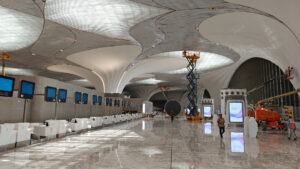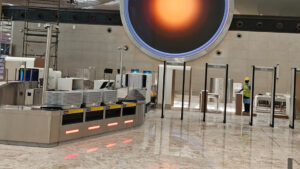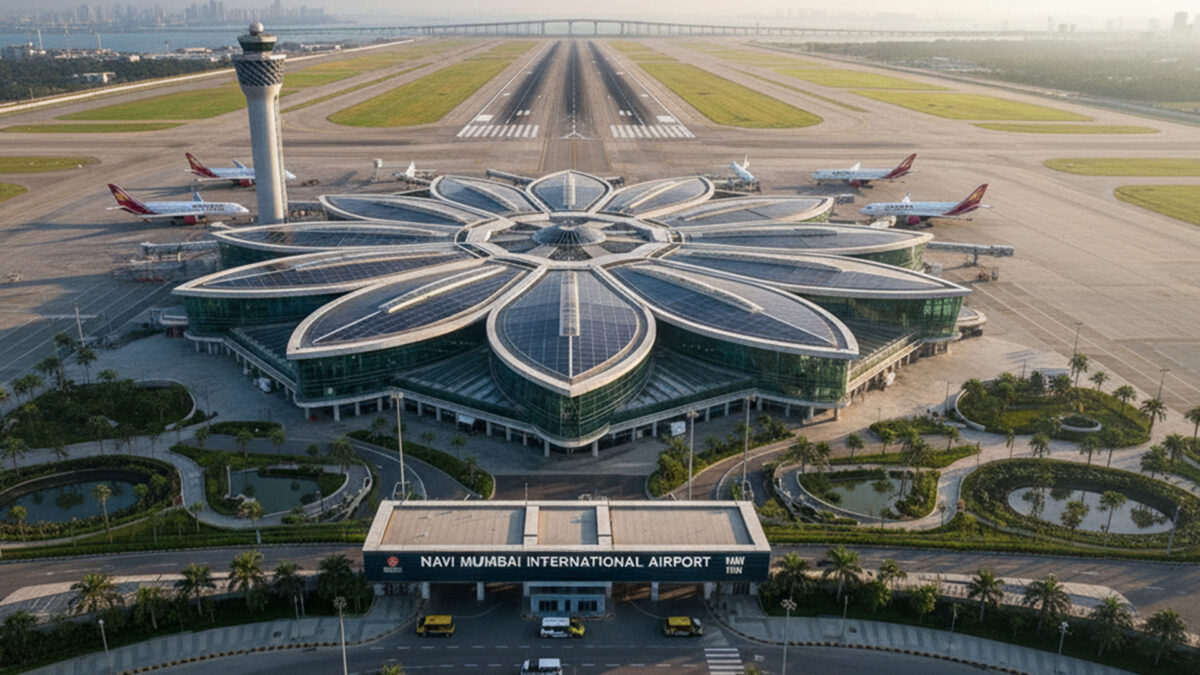When the Navi Mumbai International Airport is inaugurated, India will be unveiling not just new runways and terminals but a symbol of ambition. Rising from mangroves and mudflats, the lotus-inspired aviation hub is industrialist Gautam Adani’s attempt to transform Mumbai’s skies.
By Neha Bhaskar
Mumbai, 29 Sep 2025: Next month, on 8 October, when Prime Minister Narendra Modi inaugurates the Navi Mumbai International Airport (IATA: NMI), the moment will mark far more than the opening of another piece of critical infrastructure.
It will be the unveiling of a monument to modern India’s ambition — an airport born in adversity, sculpted through years of engineering audacity and now on its way to becoming one of the great regional aviation hubs of the world.
The date in October has been carefully chosen in an attempt to put Mumbai’s monsoon delays behind and to signal confidence that India’s most awaited airport will soon be ready for its first passengers.
For Mumbai, a packed city hemmed in by the sea and pressed to breaking point at Chhatrapati Shivaji Maharaj International Airport (IATA: BOM), the second international gateway is not a luxury but an existential need.

CSMIA is among the busiest single-runway airports in the world, straining under volumes it was never built to bear. A new airport has been spoken of for decades, but what remained only a dream for long is finally being translated into steel, concrete, glass, green and technology.
For billionaire infrastructure developer Gautam Adani and his family, the opening of NMIA is not only a matter of capacity and commerce but also a symbol of vision and succession.
This is the Group’s first greenfield airport and, more importantly for the Adani family, the first major infrastructure project to carry the imprint of the Indian industrialist’s younger son, Jeet Adani, who has been closely involved in overseeing its development.
What makes Navi Mumbai truly distinctive is that it is not just another terminal or another runway but an airport that announces itself with symbolism. Unlike the anonymous steel boxes that pass for terminals in much of the world, it will bloom with poetry.
Its lotus-inspired design, drawing on India’s national flower, turns cultural memory into living architecture. Each petal-like terminal module has been arranged to grow outward, ensuring that as traffic expands the airport can scale gracefully while still keeping passenger journeys compact and intuitive.
The lotus, often associated with resilience and purity, carries here the larger metaphor of India’s rise: rooted in tradition, yet rising above adversity into the modern light.
At full build-out, the airport will have four terminals and two parallel runways, able to handle up to 90 million passengers every year. That puts it in the same league as Heathrow, Istanbul or Dallas–Fort Worth, airports that define their cities as global hubs.
The inaugural phase alone will accommodate 20 million passengers, equivalent to the total annual traffic of entire nations such as Portugal or Greece.
The airport’s cargo handling capacity will grow from half a million tonnes to over three million, making Navi Mumbai as much a logistics giant as a passenger hub.
Inside, the experience is designed as part travel, part immersion. Passengers will encounter digital art galleries projecting the culture of Maharashtra, immersive tunnels that narrate the story of Mumbai and India through light and sound, lounges that echo the city’s café culture, children’s play zones, and forecourt plazas designed to feel like extensions of the metropolis outside.

The site itself was among the most challenging ever chosen for an airport in India. At Ulwe in Navi Mumbai, the land was a mosaic of mangroves, hillocks, rivers, dust and wetlands. Building here required one of the largest land-levelling exercises in India’s history.
Hills were flattened, rivers redirected, swamps reclaimed. More than 2,800 acres have been transformed into an aviation city. Where there was once wilderness, there now stretches a modern hub of concrete runways, glass facades and a control tower. The transformation was so immense that, for years, sceptics doubted it could ever be achieved.
Yet the location is strategic to a fault. Within sight of the newly opened Mumbai Trans Harbour Link, the longest sea bridge in India, and only a short drive from Jawaharlal Nehru Port, the country’s largest container gateway, Navi Mumbai International Airport sits at the junction of commerce and connectivity. It links seamlessly to the industrial belts of Thane, Taloja and Pune, and will eventually be tied into both the metro and suburban rail systems.
Few airports in the world sit amid such a concentration of road, rail, sea and air links. This is not simply an airport but a multimodal gateway, designed to bind together cargo flows from ship to plane, passengers from metro to terminal and businesses from factory to global markets.
The grandeur of the architecture and the ambition of the connectivity, however, rest on foundations built by sweat and grit. For nearly four years, tens of thousands of workers laboured through scorching summers and punishing monsoons. They moved earth, poured concrete, raised steel and laid tarmac, often under floodlights that turned night into day.
It is their fingerprints, calloused and unseen, that are pressed into the airport’s walls and runways. Jeet Adani, in his mid-20s when work began, took on the role of day-to-day oversight, walking the muddy site, pressing contractors and lending the project a youthful urgency.
For him, NMIA is not just an airport: it is his first signature on India’s skyline. If his elder brother Karan has become synonymous with ports and logistics, Jeet has now claimed aviation as his canvas. In that sense, Navi Mumbai is also a family milestone — a beginner’s win for the next generation.
For Gautam Adani himself, NMIA fits into a larger philosophy. As India’s most visible nationalist industrialist, his ventures are rarely framed as private enterprise alone. Ports, power plants, roads, renewable parks and now airports are woven into a larger story of nation-building.
He often argues that infrastructure is destiny, and that airports are not only gateways for trade and travel but also gateways of aspiration, shaping the impressions of millions of Indians and visitors alike.
With Mumbai finally entering the era of a dual-airport system, he is not merely operating an airport: he is etching his belief that India must match its infrastructure with its aspirations.
Technologically, Navi Mumbai aims to be one of the most advanced airports in the country. It will be among the first to adopt 5G-enabled operations, seamless biometric journeys under Digi Yatra, and IoT-driven traffic management. Cargo handling systems are semi-automated, built to handle pharmaceuticals, perishables, valuables and even live animals with world-class cold chain and security infrastructure.
Solar farms, rainwater harvesting and fleets of electric vehicles will ensure it meets stringent green standards. Where Delhi’s Indira Gandhi International remains India’s busiest with more than 70 million passengers last year, and Istanbul Airport crossed 76 million, Navi Mumbai’s eventual design capacity of 90 million places it squarely in this elite class.
No major airport in India is free from politics, and Navi Mumbai is no exception. The battle over naming rights — whether the airport should be named after Balasaheb Thackeray, the fiery founder of the Shiv Sena, or Dinkar Balu Patil, the farmer leader revered locally — continues to simmer.
In recent months, thousands of local people have demanded that the name DB Patil be affixed to the airport as recognition of his struggle on behalf of displaced farmers. Others insist that Ambedkar or Thackeray be immortalised instead. The Maharashtra government has sent multiple proposals to the centre, but no final decision has been made although Patil’s name seems to be the current frontrunner. The controversy is a reminder that airports are not just about planes and passengers: they are also about identity, pride and power.
Yet beneath the contest lies consensus: Mumbai needed this airport, India needed this airport and Adani has delivered it. When the first flights take off later this year, carrying business travellers, tourists and cargo alike, Navi Mumbai will immediately ease the pressure on the city’s skies.
Airlines such as Air India and IndiGo have already announced plans to operate dozens of flights a day from the new facility. For Maharashtra, the airport is expected to become a magnet for investment, drawing companies and talent to Navi Mumbai and beyond. For Jeet Adani, it represents a coming-of-age. And for India, it is another step in declaring to the world that its infrastructure will match its aspirations, lotus-like, rising resiliently from the mud to meet the sun.
Also Read: Trump’s India Strategy Could Backfire on US Giants: Here’s how
